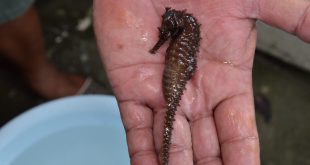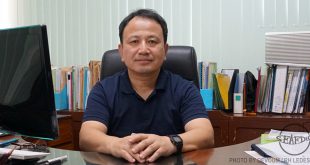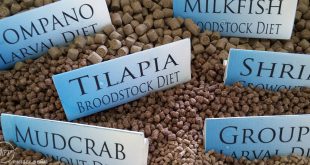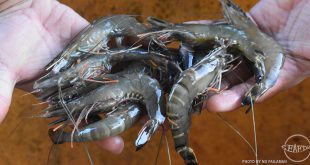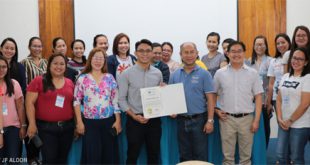Automated fish farming run by sensors, artificial intelligence, and powered by the internet and big data is seen to be the next frontier in sustainable production to meet the future demand for seafood.
Read More »SEAFDEC lab now ISO accredited
World-class quality testing can now be enjoyed by fish farmers and researchers for their feeds and water samples at the Centralized Analytical Laboratory (CAL) of SEAFDEC/AQD in Tigbauan, Iloilo.
Read More »Long-running marine fish training offered online for the first time
To surmount the limitations of the COVID-19 pandemic, SEAFDEC/AQD migrated its Marine Fish Hatchery (MarFish) training course online and conducted a first session last 14–29 June 2021.
Read More »Shrimp birthing center ends unnecessary abortions
Back in 2018, eggs from infected shrimp spawners would be promptly chlorinated and disposed – all 200,000 to 1 million of them per brood – to quell notorious pathogens that continue to devastate shrimp farms worldwide to the tune of billions of dollars yearly. This was the practice at the SEAFDEC/AQD Tiger Shrimp Spawner/Broodstock Facility in Iloilo, Philippines where incoming spawners are screened for pathogens, through polymerase chain reaction (PCR) tests, before allowing their eggs into a highly biosecure hatchery. Upon releasing their eggs, the spawners, are tested for the white spot syndrome virus (WSSV), monodon baculovirus (MBV), infectious hypodermal and hematopoietic necrosis virus (IHHNV), yellow head virus (YHV), acute hepatopancreatic necrosis disease (AHPND), and the parasite Enterocytozoon hepatopenaei (EHP). To …
Read More »Aquafeed project shows promise to improve income of farmers
To help lower the price of fish amidst volatile food prices across the country, the Southeast Asian Fisheries Development Center Aquaculture Department (SEAFDEC/AQD) is coming up with a new fish feed formulation that is cost-efficient and eco-friendly.
Read More »Revived hatchery signals major step towards Philippine milkfish fry sufficiency
The embattled milkfish industry in the Philippines got a shot in the arm as the first rehabilitated hatchery in Western Visayas, which is expected to produce 5 to 10 million bangus fry every year, started its operations to address the persistent shortage of milkfish seeds in the country. Located in the province of Aklan, the 1,787 square meter Batan Bangus Satellite Hatchery was launched in February this year under the National Fry Sufficiency Program of the Department of Agriculture’s Bureau of Fisheries and Aquatic Resources (DA-BFAR). The hatchery used to produce shrimp fry in 1983 but outbreaks of diseases in shrimp during the 90s led the hatchery to cease its operations in 1995. Now, it is one of the central …
Read More »A hard problem with a soft solution: Catfish farm’s production surges after easy fix
There are not enough catfish in the “Catfish Country” of Zarraga, Iloilo, but recent findings in one farm may just be the catalyst that could catapult the fish into abundance. Zarraga Pantat Fingerlings was one of the many farms struggling to keep pace with buyers’ demands while itself suffering from many catfish eggs that fail to hatch and catfish fry that die before they can be sold to other farmers that grow them in ponds. Larry Pañoso, the hatchery operations in-charge, said that they achieved a breakthrough in January when their production reached an all-time high of 500,000 fry per week after the Southeast Asian Fisheries Development Center Aquaculture Department (SEAFDEC/AQD) helped resolve a problem with their water …
Read More »Community-based sea ranching: fisherfolks’ legacy to sustainable fisheries
Just off Molocaboc Island, beneath a turquoise canopy of water, fishers search the coral reef to pick out abalone and sea cucumber, two prized delicacies in Asian cuisine. Live abalone sells abroad for up to $120 or approximately P5,700 a kilo, and dried sea cucumber, $2000 or about P96,000 a kilo. But the fishers are not here to cash in on the abalone grazing on coralline substrates and the sea cucumber burrowing in the white sand. Not yet. They carefully weigh and size them, log the numbers in a notebook, and return them to the reef to continue to grow and reproduce. During the formative years of the sea ranching project, the fisherfolks asked when they will benefit from the …
Read More »Profiles in Science: Peter Palma and the Case of Serendipity
Being a scientist was never part of his career plan, but this young researcher is already making waves in aquaculture research with his award-winning study on the giant grouper, a “threatened” fish locally known as lapu-lapu. Peter Palma and his team recently bagged the prestigious Dr. Elvira O. Tan Awards – Outstanding Published Paper in the Aquatic Science Category for their paper that studied the sexual development of the hermaphrodite fish and debunked presumed norms on the origin of the male giant grouper. Their paper titled “Reproductive development of the threatened giant grouper Epinephelus lanceolatus,” published in the Aquaculture Journal last July 2019, presented evidence that male giant grouper do not need to pass through a female stage at an earlier …
Read More »Disease-afflicted PH seaweed farms see hope with help of scientists
Seaweed farming, a multi-million dollar export industry in the Philippines, is at the centerpiece of a worldwide effort by scientists to better address the outbreak of diseases and pests that are plaguing the farms. With an estimated 116,000 families in the country reliant on seaweed farming, SEAFDEC/AQD as part of the UK Research and Innovation (UKRI) – Global Challenge Research Fund (GCRF) GlobalSeaweedStar Project, is working to better understand outbreaks of “ice-ice” disease and epiphyte infestations in farms which have inflicted losses worth as much as 15 percent of the total seaweed production. According to Joseph Faisan, Jr. an associate researcher at SEAFDEC/AQD, “ice-ice” disease (IID) outbreaks are caused by extreme environmental conditions (temperature, salinity, pH, siltation) and are characterized …
Read More »Japanese conservation biologist is new deputy chief of SEAFDEC/AQD
The Southeast Asian Fisheries Development Center (SEAFDEC), a regional treaty organization that promotes sustainable fisheries among its 11 member countries, welcomed the new deputy chief of its Aquaculture Department (AQD) based in Iloilo last Oct. 20, 2020. Dr. Sayaka Ito, a Japanese scientist with expertise in aquatic conservation biology, replaced fellow Japanese Dr. Koh-ichiro Mori who served as the Deputy Chief from April 2018 to June 2020 in this organization that is mandated to conduct scientific research to generate aquaculture technologies, develop skilled manpower for the aquaculture sector, and disseminate aquaculture information. Upon endorsement by the Government of Japan, SEAFDEC Secretary-General Malinee Smithrithee appointed Dr. Ito to a 2-year term from Oct. 1, 2020 to Sept. 30, 2022 wherein …
Read More »Seahorses get second life with SEAFDEC and NegOc islanders’ help
The coral reefs north of Negros Island are once more teeming with seahorses after a seven-year partnership between researchers and the local island community successfully protected and replenished their wild population. At Molocaboc Island in Sagay City, Negros Occidental, divers assisted in scientific surveys of seahorse populations, technicians maintained seahorse breeding facilities, the local government’s Bantay Dagat (sea patrol) enforced protection, and schools gladly embraced information and educations campaigns. The island is within the Sagay Marine Reserve, a marine protected area chosen as the project site of the Southeast Asian Fisheries Development Center Aquaculture Department (SEAFDEC/AQD) to protect and revive the dwindling population of the tiger tail seahorse (Hippocampus comes). During assessments done from 2012 to 2013, local divers …
Read More »From pollution to profit: Over P3-M of shrimp harvested from a hectare
By recycling excess nutrients that would otherwise have been released to the environment, a shrimp farm harvested almost 13 tons of shrimp worth P3.3 million (US$67,694) after just over 4 months of culture.
Read More »Aquafarmers hurt by lockdown woes; seek help to lower feed costs
Aquafarmers from Capiz province, dubbed “the seafood capital of the Philippines,” are feeling the sting of the pandemic as transport restrictions have driven down prices given the difficulties in distributing their milkfish, crab, and shrimp produce.
Read More »Mori completes term as SEAFDEC/AQD Deputy Chief
Dr. Koh-ichiro Mori wrapped up his stint as the outgoing Deputy Chief of the Southeast Asian Fisheries Development Center/Aquaculture Department.
Read More »Fisheries center renews call for students to do research; use labs, services
Recognizing the importance of science and research for food security, the Southeast Asian Fisheries Development Center/Aquaculture Department encourages students to pursue research in aquaculture while opening the doors of its laboratory facilities.
Read More »Sandfish: expensive, endangered, and ecologically essential
Sandfish is one of the most threatened tropical sea cucumbers because of its high price, reaching up to $1,600 per kilogram (approximately P80,800) when processed and dried into trepang or beche-de-mer which are used in exotic Asian cuisine and medicinal products.
Read More »SEAFDEC upgrades feed mill to boost production of low-cost aquaculture feeds
The quest for low-cost and eco-friendly aquafeeds received a boost with the recent US$30,800 upgrade of the feed mill of the Southeast Asian Fisheries Development Center (SEAFDEC) in Tigbauan, Iloilo.
Read More »SEAFDEC reminds shrimp growers to avoid stocking ponds during cold months
To prevent the entry of shrimp diseases, shrimp farmers are advised not to stock their ponds during cold months if their farms are not biosecurity-compliant or fully equipped to prevent the entry of shrimp diseases.
Read More »High school teachers embark on research methodology training sponsored by Japan
To enhance the capacity of local high school science teachers, a training on research methodology and technical writing was organized with funding support from the Government of Japan.
Read More » SEAFDEC/AQD Southeast Asian Fisheries Development Center | Aquaculture Department
SEAFDEC/AQD Southeast Asian Fisheries Development Center | Aquaculture Department











